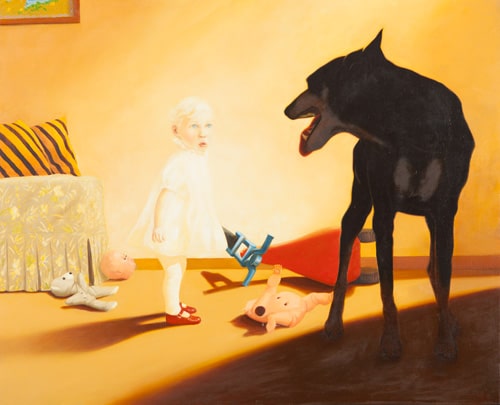
During his brief life, Nigel Thomson fulfilled the enigmatic lifestyle of the struggling artist. He would fly by the seat of his pants, improvising and surviving based on his skills as an artist. Constantly on the search for adventure, his curiosity and drive sent him on a journey that would see him evolve as one of Australia’s lesser known, but no less important, contemporary artists of the 20th century.
Thomson was born in Mosman, New South Wales in 1945.As a boy, it is said that he lived near and passed by daily, the site where missing Sydney boy Graeme Thorne had been buried. It was a shock to the community and is an experience attributable to the development of Nigel’s style – a hyper realistic exploration of the ways that the seemingly meaningless can have sinister undertones.
He left school by the age of 15 and travelled before enrolling in the Julian Ashton School of Art. After graduating in 1965 he had a few unsuccessful shows in Sydney and finally ended up in Perth in the late 1960’s. It is here that Thompson began to flourish – while still maintaining a vagrant lifestyle, he hitchhiked across the Nullabor and spent his first night here on a park bench. Regardless, he secured a job in no time as an art teacher at a secondary school in Pinjarra. “With no documents and no qualifications that he could prove … He clinched the job with three drawings he had worked up the night before his interview.” (McDonald, 2004, p. 9)
Thomson became heavily involved in the arts community in Perth; he was especially active with the WA Contemporary Art Society where he was eventually appointed president in 1970. He won several prizes during his time here and taught evenings at Perth Tech. while preparing for exhibitions. The most noted being a solo show at Skinner Gallery in October 1972. The exhibition was well received with six works sold, one to the English actor Moira Lister who invited him to contact her should he ever find himself in London. And with that, he was off to London.
Thomson exhibited extensively during his travels through England and Europe in the 70’s, he exhibited especially through the Nicholas Treadwell Gallery, London – during the height of its popularity. During this time he fully realised his style of critical realism that he would become most noted for in Australia during the 80’s and 90’s after his return to Sydney in 1979.
Twice winner of the Archibald Prize, Thomson’s works are unapologetic and meticulously crafted with the intent to evoke. In another exhibition in Perth in the 80’s one critic called his works “’an unpleasant mixture of violence, callousness, insanity, terror and anxiety.’” (McDonald, 2004, p. 5)Somewhat valid although harsh descriptions of Thompsons works, however, once you begin to consider the context behind his works, each image opens a vault of interpretations with words more like ironic, witty, sardonic and clever springing to mind.
He consumed news headlines and popular culture incessantly, was possessed by the need to expose the hypocrisies of modern society and does so with subtle integrity. The sheer fact that Thomson’s works can elicit such powerful responses is only a testament to his staple within the canon of important contemporary Australian artists.
In this image, painted in 1985 during the apex of his career, we can see the subtle dichotomy between light and dark, innocence and menace. Upon closer inspection, the viewer will notice the delicate nuances that make Thomson’s work so intriguing. Once the eye looks past the unsettling large dog in the darkened foreground that overshadows the seemingly innocent child, you begin to notice the stuffing pulled from the teddy bear, the punctures in the doll, the menace behind the innocence of the child, and the innocence in expression behind the menace of the dog, you begin to question which subject is really in danger here.
The breadth of Thomson’s work is not extensive; he destroyed a large portion of his early works “describing them as acts of undergraduate humour or potboilers.” (McDonald, 2004, p. 7)
This, combined with his early death due to cancer in 1999, cut short a very promising body of work. In the past two decades since his death only four works have been offered on the secondary market making owners of his paintings the envy of any serious collector of contemporary Australian art.
Olivia Gardner
References
McDonald, J. (2004). Nigel Thomson Critical Realist. Manly, NSW, Australia: Manly Art Gallery & Museum.
